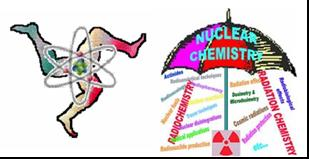Prof.
Pavel Povinec
(Comenius University of Bratislava)
21/09/2011, 11:00
Radioecology and Geochemistry
oral presentation
The recent developments in ultra low-level radionuclide analyses include in the radiometrics sector availability of large volume HPGe detectors operating in underground laboratories very often with additional anti-cosmic shielding. In the mass spectrometry sector they include applications of Accelerator Mass Spectrometry (AMS), Inductively Coupled Plasma Mass Spectrometry (ICPMS) and Resonance...
Dr
Maria do Carmo Freitas
(Instituto Tecnológico e Nuclear)
21/09/2011, 11:20
Radioecology and Geochemistry
oral presentation
The main objective of this study is the elemental characterization of geomaterial samples (“soils”, rañas and mother rocks), in terms of rare earth elements (REE), collected between 2007 and 2008, in the Morais Massif, (NE Mainland of Portugal) by using Instrumental Neutron Activation Analysis (INAA). The group of samples labeled “soil”, includes representative portions of the inorganic...
Paulo Ferreira
(University of São Paulo)
21/09/2011, 11:35
Radioecology and Geochemistry
oral presentation
Cs-137 is among the main isotopes produced in U-235 fission in nuclear explosions. It has a high fission yield, half-life of 30.17 years and decays to Ba-137 through β and γ emissions. As Cs-137 has a strong affinity to marine particulate matter, it tends to accumulate in sediments.
This nuclide is largely used for estimating sedimentation rates, since historical dates of Cs-137 liberation in...
Prof.
ALEXANDRA IOANNIDOU
(ARISTOTLE UNIVERSITY OF THESSALONIKI, Physics Department, Nuclear Phys. and Elementary Particle Phys. Division)
21/09/2011, 11:50
Radioecology and Geochemistry
oral presentation
The activity size distributions of the natural radionuclide tracer 7Be were determined in different site places in Northern Italy in order to define any differences due to the different environments. In the frame of this work, three different environments where chosen, in an urban area (University of Milano), in a rural residential area (Ispra) and in Maqugnaga village at 1300 m height in...
Prof.
Trinidad Martinez
(National University of Mexico)
21/09/2011, 12:05
Radioecology and Geochemistry
oral presentation
Marine sediments from West coast of Mexico in the Pacific Sea from Sinaloa to Jalisco, Mexico were analyzed by the energy-dispersive X-ray fluorescence technique (EDXRF). 9 sediment samples were collected in May, 2010 at water depths between 55.5 and 1264 m with a box nucleate sampler type Reinneck. Sediments were dried and the total and separated fine fraction analyzed. Concentration and...
Prof.
Alexander Bolsunovsky
(Institute of Biophysics SB Russian Academy of Sciences)
21/09/2011, 12:20
Radioecology and Geochemistry
oral presentation
The Yenisei River is contaminated with artificial radionuclides released by one of the Russian nuclear facilities (Mining-and-Chemical Combine), which has been producing weapons-grade plutonium since 1958. The submerged plants growing on radioactively contaminated river bottom sediments contain artificial radionuclides. Sequential extraction techniques are the most common method of studying...
Dr
Szabina Torok
(KFKI Atomic Energy Research Institute)
21/09/2011, 12:35
Radioecology and Geochemistry
oral presentation
Argillaceous rocks are being considered in many radioactive waste management programmes as suitable host rock formations for the deep geological disposal of radioactive waste. Clay minerals such as illite, smectite, illite/smectite mixed layers and kaolinite are important components in such rock types and can often make up 50 or more wt.% of the total mass. One of the most important...
Mr
Kamil Brudecki
(The Henryk Niewodniczanski Institute of Nuclear Physics, Polish Academy of Sciences,)
21/09/2011, 12:50
Radioecology and Geochemistry
oral presentation
As a result of strong earthquake near Japan Islands followed by tsunami wave on 11 of March 2011 a serious damage caused by overheating occurred to reactors of the Fukushima Daiichi Nuclear Power Plant. Uncontrolled radioactive emission to the atmosphere started on 12 of March and was lasting for more than 2 weeks. Radioactive cloud migrated across Pacific, Northern America and came to Europe...
Dr
Sergey Gordeev
(Scientific and Industrial Association "Radon")
21/09/2011, 13:05
Radioecology and Geochemistry
oral presentation
As a result of the accident at the “Fukushima” nuclear power plant, caused by an earthquake, there were releases of radioactive substances into the environment.
To date, many countries reported on the flow of radioactive aerosols from Japan and the radioactive contamination of the environment, as well as food (1,2,3,4).
Intake of radioactive aerosols in Moscow was registered at radiation...
